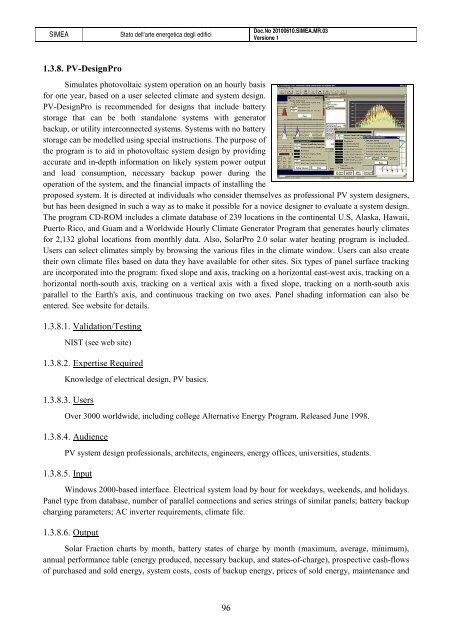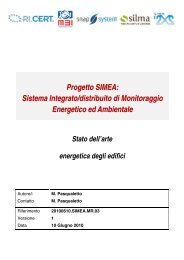Progetto SIMEA - Automatica - Università degli Studi di Padova
Progetto SIMEA - Automatica - Università degli Studi di Padova
Progetto SIMEA - Automatica - Università degli Studi di Padova
Create successful ePaper yourself
Turn your PDF publications into a flip-book with our unique Google optimized e-Paper software.
<strong>SIMEA</strong> Stato dell’arte energetica <strong>degli</strong> e<strong>di</strong>fici<br />
1.3.8. PV-DesignPro<br />
96<br />
Doc.No 20100610.<strong>SIMEA</strong>.MR.03<br />
Versione 1<br />
Simulates photovoltaic system operation on an hourly basis<br />
for one year, based on a user selected climate and system design.<br />
PV-DesignPro is recommended for designs that include battery<br />
storage that can be both standalone systems with generator<br />
backup, or utility interconnected systems. Systems with no battery<br />
storage can be modelled using special instructions. The purpose of<br />
the program is to aid in photovoltaic system design by provi<strong>di</strong>ng<br />
accurate and in-depth information on likely system power output<br />
and load consumption, necessary backup power during the<br />
operation of the system, and the financial impacts of installing the<br />
proposed system. It is <strong>di</strong>rected at in<strong>di</strong>viduals who consider themselves as professional PV system designers,<br />
but has been designed in such a way as to make it possible for a novice designer to evaluate a system design.<br />
The program CD-ROM includes a climate database of 239 locations in the continental U.S, Alaska, Hawaii,<br />
Puerto Rico, and Guam and a Worldwide Hourly Climate Generator Program that generates hourly climates<br />
for 2,132 global locations from monthly data. Also, SolarPro 2.0 solar water heating program is included.<br />
Users can select climates simply by browsing the various files in the climate window. Users can also create<br />
their own climate files based on data they have available for other sites. Six types of panel surface tracking<br />
are incorporated into the program: fixed slope and axis, tracking on a horizontal east-west axis, tracking on a<br />
horizontal north-south axis, tracking on a vertical axis with a fixed slope, tracking on a north-south axis<br />
parallel to the Earth's axis, and continuous tracking on two axes. Panel sha<strong>di</strong>ng information can also be<br />
entered. See website for details.<br />
1.3.8.1. Validation/Testing<br />
NIST (see web site)<br />
1.3.8.2. Expertise Required<br />
Knowledge of electrical design, PV basics.<br />
1.3.8.3. Users<br />
Over 3000 worldwide, inclu<strong>di</strong>ng college Alternative Energy Program. Released June 1998.<br />
1.3.8.4. Au<strong>di</strong>ence<br />
PV system design professionals, architects, engineers, energy offices, universities, students.<br />
1.3.8.5. Input<br />
Windows 2000-based interface. Electrical system load by hour for weekdays, weekends, and holidays.<br />
Panel type from database, number of parallel connections and series strings of similar panels; battery backup<br />
charging parameters; AC inverter requirements, climate file.<br />
1.3.8.6. Output<br />
Solar Fraction charts by month, battery states of charge by month (maximum, average, minimum),<br />
annual performance table (energy produced, necessary backup, and states-of-charge), prospective cash-flows<br />
of purchased and sold energy, system costs, costs of backup energy, prices of sold energy, maintenance and
















